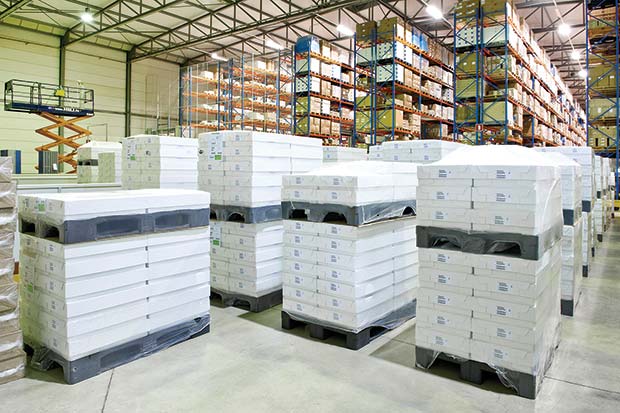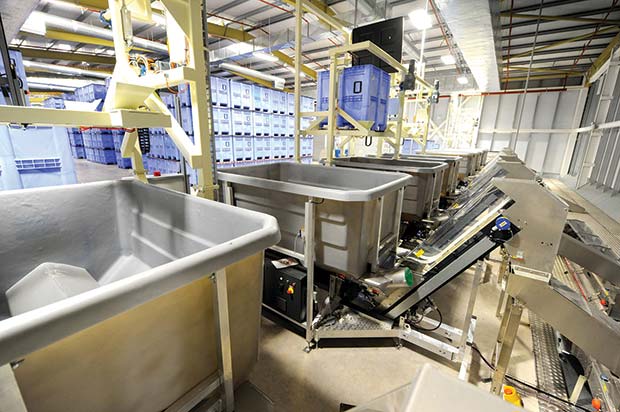Integrating pallets and crates into modern automated handling systems requires careful planning. Jim Hardisty, MD of Goplasticpallets.com explains.
 We’ve been receiving an increasing number of enquiries from customers seeking advice on selecting suitable products to use in automated handling systems.
We’ve been receiving an increasing number of enquiries from customers seeking advice on selecting suitable products to use in automated handling systems.
There was a time when logistics professionals wouldn’t have thought twice about using the ubiquitous wooden pallet for automated handling. However, times have changed and the increasing complexity of modern warehouse operations and the high-value investment in creating automated systems that work safely and efficiently demands more reliable transit products.
Optimising materials movement in warehouses involves a considerable amount of time and financial investment. Consideration must be given to the available floor space, how goods are received, stored, picked and shipped, and the level of labour required. A thorough evaluation will determine the best automated solutions; whether that’s introducing automatic stacker cranes to replace manual forklifts for faster order picking and retrieval, or introducing automated conveyor systems for transporting, accumulating and distributing goods to specific warehouse locations.
Today’s warehouses are under increasing pressure to reduce operational costs, generate higher productivity and improve service levels. Introducing the most suitable pallet or crate into automated processes is therefore crucial to guarantee optimum safety, minimise system downtime and maximise cost-effectiveness.
Guarantee optimum safety
Automated handling requires that the unit load – be it a carton, crate, tray or pallet – be uniform in all aspects. That means a product of both consistent size and strength. If we take the traditional wooden pallet as an example, whether new or reused, there is no way of determining its exact dimensions and strength since wooden pallets do not have guaranteed loading capacities.
The reason for this is that the strength of timber varies, as growing conditions, including the climate in which the wood is cultivated, determine the quality and strength of the end product. Make 100 wooden pallets one month and test them and they might all have the same loading capacity, but make another 100 pallets a few months later and there is no telling how the capacity of these pallets might differ.
In contrast, the properties of plastic never change, so moulding plastic under extreme pressure in highly polished moulds ensures the consistent dimensional accuracy and loading capacities of every plastic pallet. By using pallets that have stated loading capacities in automatic storage and retrieval systems (AS/RS), warehouse managers can be sure that goods are being stored, racked and transported in the safest possible way.

Last year a major UK supermarket chain trialled some of our plastic pallets in their automated storage system after a wooden pallet racked 10-racks high broke causing a pyramid effect that destroyed a huge volume of product and cost £2.5m to resolve. Thankfully, no one was injured but, had staff been present in the warehouse at the time, the incident could have been life-threatening.
Minimise system downtime
Damaged wooden pallets as well as pallets with signs of heavy and frequent use can cause malfunctions on automated conveyor systems. When nails and splinters get trapped or loose component parts break off, the defective pallet must be manually removed, resulting in system downtime and unplanned and unwanted costs for the operator. Each stoppage increases the backlog impacting negatively on productivity.
With plastic pallets system downtime and unnecessary costs can be avoided since there is no risk of nails, splinters and loose component parts causing blockages, so systems can run continuously at full capacity with little need for manual intervention.
Maximise cost-effectiveness
Receiving goods into warehouses on wooden pallets or one-trip disposable pallets that are not compatible with automated systems has additional handling and cost implications for the warehouse operator. Palletised goods must be re-palletised onto a more reliable pallet – for instance a full perimeter plastic pallet – to ensure a smooth integration with automated processes. This can often mean extra handling procedures at both the inward and outward points of an automated storage system, if goods are to be shipped on the incoming wooden pallets.

Of course a ‘one size fits all’ solution will never be a reality in automated handling – the required use will determine which product is the best fit – although in many scenarios, reusable plastic pallets and crates are an all-round safe, reliable and cost-effective choice.
Goplasticpallets.com
Tel: 01323 744057




Comments are closed.